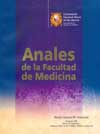Insulin resistance in overweight and obese adolescents
DOI:
https://doi.org/10.15381/anales.v67i1.1291Keywords:
Insulin resistence, obesity, weight gain, adolescenceAbstract
Objective: To determine the presence of insulin resistance (IR) in a group of overweight and obese adolescents. Materials and Methods: One hundred 10 to 28 year-old children were studied, (77% females); 67% were overweight and the remaining obese. Overweight and obesity were determined by Must et al. criteria: overweight between 85 and 95 percentile and obesity overt the 95 percentile. Glycemia and basal insulin were determined in serum obtained by vein puncture. IR was determined by HOMA’s index considering Keskin diagnosis value of 3,1. Results: There was no biochemical statistical difference between the overweight and obesity groups; 14% showed IR, 16,2% in the obese children and 12,3% in those overweight. Average insulin and HOMA in obese children with IR were 315 uUl/mL and 7, respectively. The insulin and HOMA difference between those with and without IR was statistically significant. (p<0,0001). Waist circumference below the median was found in 16% with IR and 12% in the other group. Conclusions: Most of the overweight and obese adolescents in the group studied did not have insulin resistance and only 14% presented IR -16,2% in the obese and 12,3% in those overweight. The existence of IR in adolescents implies higher cardiovascular risk in those overweight and obese and requires preventive measures to face this problem.Downloads
Published
2006-03-13
Issue
Section
Trabajos originales
License
Copyright (c) 2006 Jaime Pajuelo, Rosa Pando, María Leyva, Karina Hernández, Rocío Infantes

This work is licensed under a Creative Commons Attribution-NonCommercial-ShareAlike 4.0 International License.
Those authors who have publications with this magazine accept the following terms:
- Authors will retain their copyrights and guarantee the journal the right of first publication of their work, which will be simultaneously subject to Creative Commons Attribution License that allows third parties to share the work as long as its author and its first publication this magazine are indicated.
- Authors may adopt other non-exclusive licensing agreements for the distribution of the version of the published work (eg, deposit it in an institutional electronic file or publish it in a monographic volume) provided that the initial publication in this magazine is indicated.
- Authors are allowed and recommended to disseminate their work over the Internet (eg: in institutional telematic archives or on their website) before and during the submission process, which It can produce interesting exchanges and increase quotes from the published work. (See El efecto del acceso abierto ).
How to Cite
1.
Pajuelo J, Pando R, Leyva M, Hernández K, Infantes R. Insulin resistance in overweight and obese adolescents. An Fac med [Internet]. 2006 Mar. 13 [cited 2025 Jun. 2];67(1):23-9. Available from: https://revistasinvestigacion.unmsm.edu.pe/index.php/anales/article/view/1291



